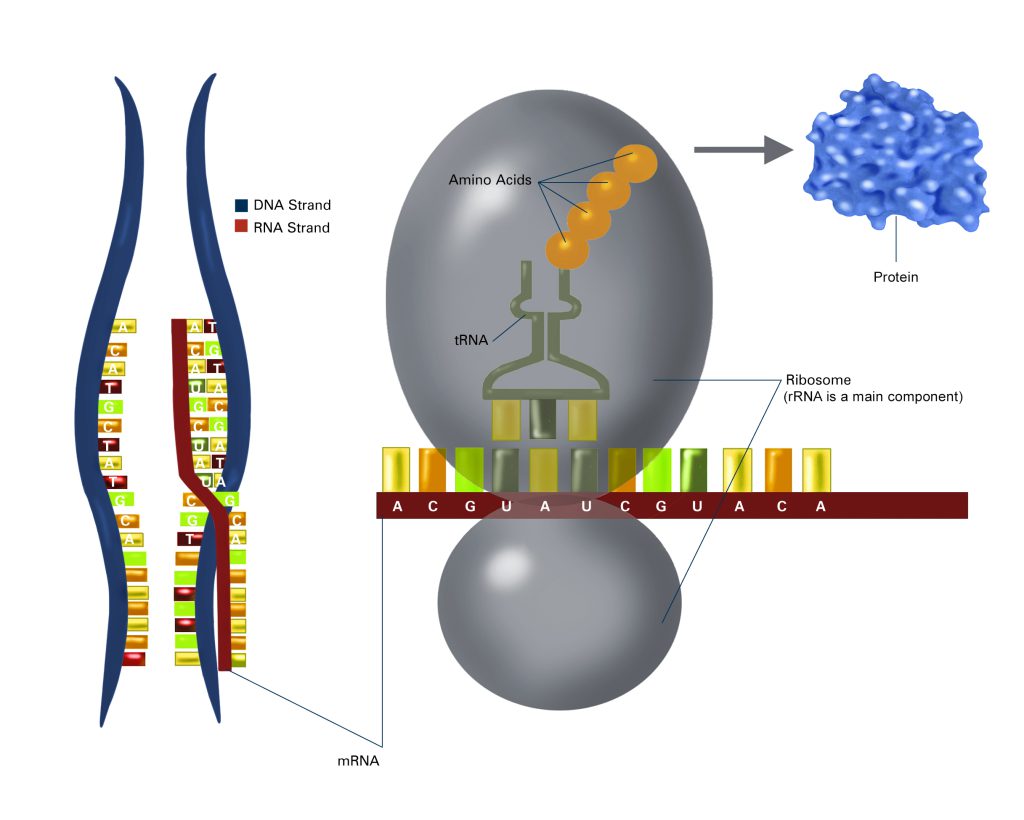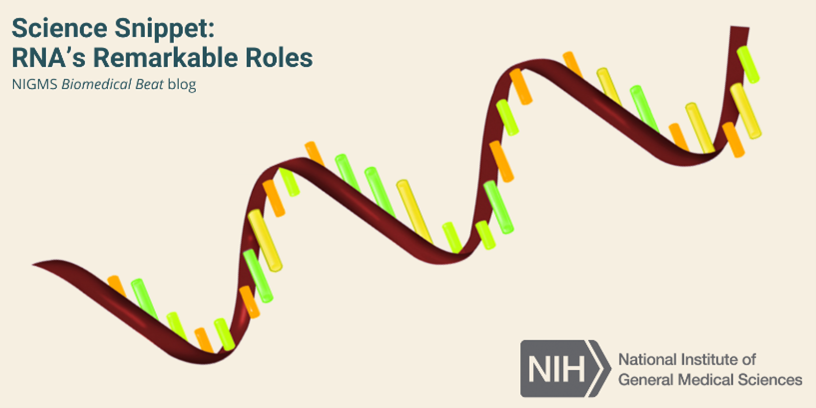RNA, though less well known than its cousin DNA, is equally integral to our bodies. RNA molecules are long, usually single-stranded chains of nucleotides. (DNA molecules are also made up of nucleotides but are typically double-stranded.) There are three major types of RNA, which are all involved in protein synthesis:
- Messenger RNA (mRNA) is complementary to one of the DNA strands of a gene and carries genetic information for protein synthesis to the ribosome—the molecular complex in which proteins are made.
- Transfer RNA (tRNA) works with mRNA to make sure the right amino acids are inserted into the forming protein.
- Ribosomal RNA (rRNA), together with proteins, makes up ribosomes and functions to recognize the mRNA and tRNA that are presented to the ribosomal complex.
Proteins are essential for virtually every process in our bodies, and without RNA, they wouldn’t be made.

In addition to the RNA molecules involved in protein synthesis, our cells create other types of RNA that play a range of roles. For example, some act like enzymes, speeding up chemical reactions, while others regulate gene expression.
Researchers have developed tools to read the nucleotide sequences of RNA molecules. By determining which RNA molecules cells are building, scientists can tell which genes are being expressed. Researchers can compare gene expression information from people with and without a disease to better understand the effects of the disease at the cellular level. This understanding can also support the development of diagnostic tools and therapeutic treatments.
In addition, RNA can be used to help protect against disease, as demonstrated by the COVID-19 mRNA vaccines. These vaccines contain mRNA that codes for a specific protein—called the spike protein—of the virus that causes COVID-19. Just as they do with our own mRNA, our cells translate this vaccine mRNA to produce the encoded protein, in this case spike proteins. The proteins can’t cause COVID-19 by themselves, but the immune system recognizes them as foreign and creates targeted antibodies to attack them. Even after the proteins are destroyed, specialized immune cells “remember” the spike protein. If the virus that causes COVID-19 enters a vaccinated person’s body, the immune system reacts with antibodies that defend against infection more swiftly than it could if it had never seen the spike protein.
NIGMS-Funded RNA Research
Many scientists supported by NIGMS study RNA. Some of these researchers are:
- Investigating how cells detect and degrade defective RNA to maintain health. Defective RNA has been linked to conditions including myotonic dystrophy, prostate cancer, Fragile X syndrome, and amyotrophic lateral sclerosis.
- Developing tools to predict and analyze the 3D shapes of RNAs. The molecules’ shapes are important for their functions, and better understanding their shapes could assist the development of therapies that use or target RNAs.
- Studying how RNA prevents gene expression, which could aid efforts to harness this process to treat genetic diseases.
- Determining if RNA sequencing data can support the diagnosis and treatment of sepsis.
Learn about other scientific terms with the NIGMS glossary.



I noticed not comment on this RNA science snippet, so l’ll say I enjoyed reading your post. Keep up the good work!
John
The fascination between the bacterium and the host has fascinated me since school days. Exciting!
It’s nice to see a story that reflects some early science which may bring in more aspiring scientists.